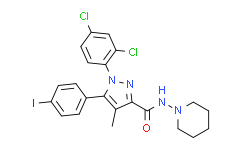| 中文名称: | AM251 | ||||
|---|---|---|---|---|---|
| 英文名称: | AM251 | ||||
| 别名: | 1-(2,4-二氯苯基)-5-(4-碘苯基)-4-甲基-N-(哌啶-1-基)-1H-吡唑-3-甲酰胺 1-(2,4-Dichlorophenyl)-5-(4-iodophenyl)-4-methyl-N-(piperidin-1-yl)-1H-pyrazole-3-carboxamide | ||||
| CAS No: | 183232-66-8 | 分子式: | C22H21Cl2In4O | 分子量: | 555.24 |
| CAS No: | 183232-66-8 | ||||
| 分子式: | C22H21Cl2In4O | ||||
| 分子量: | 555.24 | ||||
| MDL: | MFCD01861181 | ||||
包装规格:
5mg 10mg 25mg 50mg 100mg in glass bottle
产品简介:
一种选择性大麻素1 (CB1)受体拮抗剂,IC50为8nM。AM25也是GPR55 的激动剂,EC50为39nM。
溶解性:
溶于DMSO(25mg/mL 超声)
储备液保存:
-80°C, 2 years
-20°C, 1 year
-20°C, 1 year
体内实验:
1、请依序添加每种溶剂: 10% DMSO→40% PEG300→5% Tween-80→45% Saline
Solubility: ≥ 2.5 mg/mL (4.50 mM); 澄清溶液
此方案可获得 ≥ 2.5 mg/mL(饱和度未知)的澄清溶液。
以 1 mL 工作液为例,取 100 μL 25.0 mg/mL 的澄清 DMSO 储备液加到 400 μL PEG300 中,混合均匀;再向上述体系中加入 50 μL Tween-80,混合均匀;然后再继续加入 450 μL 生理盐水 定容至 1 mL。
2、请依序添加每种溶剂: 10% DMSO→90% Corn Oil
Solubility: ≥ 2.5 mg/mL (4.50 mM); 澄清溶液
此方案可获得 ≥ 2.5 mg/mL(饱和度未知)的澄清溶液,此方案实验周期在半个月以上的动物实验酌情使用。
以 1 mL 工作液为例,取 100 μL 25.0 mg/mL 的澄清 DMSO 储备液加到 900 μL玉米油中,混合均匀。
<1mg/ml表示微溶或不溶。
普西唐提供的所有化合物浓度为内部测试所得,实际溶液度可能与公布值有所偏差,属于正常的批间细微差异现象。
请根据产品在不同溶剂中的溶解度选择合适的溶剂配制储备液;一旦配成溶液,请分装保存,避免反复冻融造成的产品失效。
Solubility: ≥ 2.5 mg/mL (4.50 mM); 澄清溶液
此方案可获得 ≥ 2.5 mg/mL(饱和度未知)的澄清溶液。
以 1 mL 工作液为例,取 100 μL 25.0 mg/mL 的澄清 DMSO 储备液加到 400 μL PEG300 中,混合均匀;再向上述体系中加入 50 μL Tween-80,混合均匀;然后再继续加入 450 μL 生理盐水 定容至 1 mL。
2、请依序添加每种溶剂: 10% DMSO→90% Corn Oil
Solubility: ≥ 2.5 mg/mL (4.50 mM); 澄清溶液
此方案可获得 ≥ 2.5 mg/mL(饱和度未知)的澄清溶液,此方案实验周期在半个月以上的动物实验酌情使用。
以 1 mL 工作液为例,取 100 μL 25.0 mg/mL 的澄清 DMSO 储备液加到 900 μL玉米油中,混合均匀。
<1mg/ml表示微溶或不溶。
普西唐提供的所有化合物浓度为内部测试所得,实际溶液度可能与公布值有所偏差,属于正常的批间细微差异现象。
请根据产品在不同溶剂中的溶解度选择合适的溶剂配制储备液;一旦配成溶液,请分装保存,避免反复冻融造成的产品失效。
靶点:
IC50: 8 nM (CB1 receptor)
体外研究:
AM251 is a CB1 receptor antagonist/inverse agonist. AM251 produces an agonist response in HEK293 cells, similar to that found in the yeast expression system.
AM-251 reduces cholesteryl ester synthesis in unstimulated and acetylated LDL-stimulated Raw 264.7 macrophages, CB2+/+ and CB2-/- peritoneal macrophages.
AM-251 reduces cholesteryl ester synthesis in unstimulated and acetylated LDL-stimulated Raw 264.7 macrophages, CB2+/+ and CB2-/- peritoneal macrophages.
体内研究:
The CB1 antagonist AM251 (3 mg/kg, i.p.) decreases capsaicin-evoked nocifensive behavior. This suppressive effect is genotype dependent, and the interaction between the effects of genotype and AM251 approached significance. Planned comparisons reveal that AM251 reduces nocifensive behaviors in fatty-acid amide hydrolase (FAAH) KO mice (p<0.01) but fails to alter nocifensive behavior in WT mice (p>0.2) relative to their respective vehicle controls. AM251 (3 mg/kg, i.p.) reduces the duration of heat hypersensitivity in FAAH KO (F1,9=21.43, p<0.01) but not WT mice (p>0.3). AM251 suppresses capsaicin-evoked heat hypersensitivity in a time-dependent manner in FAAH KO (F5,9=4.349, p<0.01) but not in WT mice (p>0.3). Post-hoc analysis reveals that FAAH KO mice receiving vehicle (i.p.) display heightened thermal hypersensitivity at 30 (p<0.05), 60 (p<0.05), and 90 (p<0.001) minutes post-capsaicin in comparison to FAAH KO animals receiving AM251).
One-way ANOVA shows that AM251 (AM-251) injected into the rats significantly decreases both of the percentage of entries in the open arms and time spent in the open arms, compare to controls. The Tukey-Kramer test analysis reveals a significant reduction for the doses of 1 mg/kg (P<0.05) and 5 mg/kg (P<0.01) compare to control rats in the time spent in the open arms. Also, AM251 significantly decreases percentage of entries in the open arms for the doses of 1 and 5 mg/kg (P<0.05).
One-way ANOVA shows that AM251 (AM-251) injected into the rats significantly decreases both of the percentage of entries in the open arms and time spent in the open arms, compare to controls. The Tukey-Kramer test analysis reveals a significant reduction for the doses of 1 mg/kg (P<0.05) and 5 mg/kg (P<0.01) compare to control rats in the time spent in the open arms. Also, AM251 significantly decreases percentage of entries in the open arms for the doses of 1 and 5 mg/kg (P<0.05).
激酶实验:
Caspase-3 试验:
巨噬细胞接种(2×106/孔)在12孔培养板。从2 mg/mL乙醇储备液中加入7-酮基胆固醇之前1小时,加入DMSO 中制备的4 mM AM-25储备液。调节对照组,达到等体积的DMSO和乙醇。16小时后,测定caspase-3的活性。所有处理重复3次进行,数据以平均RFLU/mg蛋白质表示。
巨噬细胞接种(2×106/孔)在12孔培养板。从2 mg/mL乙醇储备液中加入7-酮基胆固醇之前1小时,加入DMSO 中制备的4 mM AM-25储备液。调节对照组,达到等体积的DMSO和乙醇。16小时后,测定caspase-3的活性。所有处理重复3次进行,数据以平均RFLU/mg蛋白质表示。
动物实验:
动物模型:适度肥胖的雄性 Lewis 大鼠
剂量:1.25 mg/kg,2.5 mg/kg 和 5 mg/kg
给药处理:i.p.
剂量:1.25 mg/kg,2.5 mg/kg 和 5 mg/kg
给药处理:i.p.
保存条件:
-20℃
注意事项:
1、为了您的安全和健康,请穿实验服并戴一次性手套操作。
2、以上信息仅做参考交流之用。
2、以上信息仅做参考交流之用。
UN码:
HazardClass:
危害声明:
安全说明:
搜索质检报告(COA)
参考文献 & 客户发表文献
本计算器可帮助您计算出特定溶液中溶质的质量、溶液浓度和体积之间的关系,公式为:
质量 (g) = 浓度 (mol/L) x 体积 (L) x 分子量 (g/mol)
摩尔浓度计算公式
用本工具协助配置特定浓度的溶液,使用的计算公式为:
开始浓度 x 开始体积 = 最终浓度 x 最终体积
稀释公式
稀释公式一般简略地表示为:C1V1 = C2V2 ( 输入 输出 )








